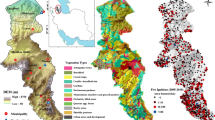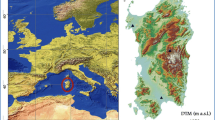Abstract
The purpose of this study was to assess spatial wildfire risk in a typical Mediterranean wildland–urban interface (WUI) in Greece and the potential effect of three different burning condition scenarios on the following four major wildfire risk components: burn probability, conditional flame length, fire size, and source–sink ratio. We applied the Minimum Travel Time fire simulation algorithm using the FlamMap and ArcFuels tools to characterize the potential response of the wildfire risk to a range of different burning scenarios. We created site-specific fuel models of the study area by measuring the field fuel parameters in representative natural fuel complexes, and we determined the spatial extent of the different fuel types and residential structures in the study area using photointerpretation procedures of large scale natural color orthophotographs. The results included simulated spatially explicit fire risk components along with wildfire risk exposure analysis and the expected net value change. Statistical significance differences in simulation outputs between the scenarios were obtained using Tukey’s significance test. The results of this study provide valuable information for decision support systems for short-term predictions of wildfire risk potential and inform wildland fire management of typical WUI areas in Greece.








Similar content being viewed by others
References
Ager A, McMahan A, Barrett J, McHugh C (2007) A simulation study of forest restoration and fuels treatments on a wildland–urban interface. Landscape Urban Plan 80:292–300
Ager A, Finney M, McMahan A, Cathcart J (2010) Measuring the effect of fuel treatments on forest carbon using landscape risk analysis. Nat Hazard Earth Syst 10:2515–2526
Ager A, Vaillant N, Finney M, Preisler H (2012) Analyzing wildfire exposure and source-sink relationships on a fire-prone forest landscape. For Ecol Manage 267:271–283
Andrews P, Finney M, Fischetti M (2007) Predict Wildfires Sci Am 1:47–55
Andrews P, Heinsch F, Schelvan L (2011) How to generate and interpret fire characteristics charts for surface and crown fire behavior. USDA, Forest Service, Rocky Mountain Research Station, General Technical Report, RMRS-GTR-253. Fort Collins, CO
Arca B, Duce P, Laconi M, Pellizzaro G, Salis M, Spano D (2007) Evaluation of FARSITE simulator in Mediterranean maquis. Int J Wildland Fire 16:563–572
Arca B, Pellizzaro G, Duce P, Salis M, Bacciu V, Spano D, Ager A, Finney M, Scoccimarro E (2012) Potential changes in fire probability and severity under climate change scenarios in Mediterranean areas. In: Spano D, Bacciu V, Salis M, Sirca C (eds) Modelling fire behaviour and risk. NuovaStampacolor, Sassari, pp 92–98
Arroyo L, Pascual C, Manzanera J (2008) Fire models and methods to map fuel types: the role of remote sensing. For Ecol Manage 256:1239–1252
Bachmann A, Allgower B (2001) A consistent wildland fire risk terminology is needed. Fire Manage Today 61:28–33
Blanchi R, Jappiot M Alexandrian D (2002) Forest fire risk assessment and cartography. A methodological approach. In: Viegas, D (ed). Proceedings of the IV International Conference on Forest Fire Research. Luso, Portugal
Bonham C (1989) Measurements for terrestrial vegetation. Wiley, New York
Brown J, Oberheu R, Johnston C (1982) Handbook for inventorying surface fuels and biomass in the Interior West. USDA Forest Service, Intermountain Forest and Range Experiment Station General Technical Report INT-129. Ogden
Calkin DE, Ager AA, Gilbertson-Day J (2010) Wildfire risk and hazard: Procedures for the first approximation. USDA, Forest Service, Rocky Mountain Research Station, General Technical Report, RMRS-GTR-235. Fort Collins, CO
Calkin D, Ager A, Thompson M (2011) A comparative risk assessment framework for wildland fire management: the 2010 cohesive strategy science report. USDA, Forest Service, Rocky Mountain Research Station, General Technical Report RMRS-GTR-262. Fort Collins, CO
Calkin D, Cohen J, Finney M, Thompson M (2014) How risk management can prevent future wildfire disasters in the wildland–urban interface. PNAS 111(2):746–751
Carmel Y, Paz S, Jahashan F, Shoshany M (2009) Assessing fire risk using Monte Carlo simulations of fire spread. For Ecol Manage 257:370–377
Catry F, Rego F, Bação L, Moreira F (2009) Modelling and mapping wildfire ignition risk in Portugal. Int J Wildland Fire 18:921–931
Chuvieco E, Aguado I, Yebra M, Nieto H, Salas J, Martín M, Zamora R (2010) Development of a framework for fire risk assessment using remote sensing and geographic information system technologies. Ecol Model 221:46–58
Chuvieco E, Aguado I, Jurdao S, Pettinari M, Yebra M, Salas J, Hantson S, de la Riva J, Ibarra P, Rodrigues M, Echeverria M, Azqueta D, Roman M, Bastarrika A, Martinez S, Recondo C, Zapico E, Martinez-Vega F (2012) Integrating geospatial information into fire risk assessment. Int J Wildland Fire 2:69–86
Cleve C, Kelly M, Kearns F, Moritz M (2008) Classification of the wildland–urban interface: a comparison of pixel- and object-based classifications using high-resolution aerial photography. Comput Environ Urban Syst 32:317–326
Dimitrakopoulos A (2001) PYROSTAT—a computer program for forest fire data inventory and analysis in Mediterranean countries. Environ Modell Softw 16:351–359
Dimitrakopoulos A (2002) Mediterranean fuel models and potential fire behaviour in Greece. Int J Wildland Fire 11:127–130
Dimitrakopoulos A, Panov P (2001) Pyric properties of some dominant Mediterranean vegetation species. Int J Wildland Fire 10:23–27
European Union (2011) Mapping Guide for a European Urban Atlas, p 31
Fairbrother A, Turnley J (2005) Predicting risks of uncharacteristic wildfires: application of the risk assessment process. For Ecol Manage 211:28–35
Finney M (2002) Fire growth using minimum travel time methods. Can J For Res 32:1420–1424
Finney M (2005) The challenge of quantitative risk analysis for wildland fire. For Ecol Manage 211:97–108
Finney M (2006) An overview of FlamMap modeling capabilities. In: Andrews P, Butler B (eds.) Fuels Management—How to measure success: Conference Proceedings. USDA, Forest Service, Rocky Mountain Research Station, General Technical Report, RMRS-P-41, pp 213–219
Finney M, Grenfell I, McHugh C (2009) Modeling containment of large wildfires using generalized linear mixed-model analysis. For Sci 55:249–255
Finney M, Grenfell I, McHugh C, Seli R, Tretheway D, Stratton R, Brittain S (2011) A method for ensemble wildland fire simulation. Environ Model Assess 16:153–167
Forthofer J (2007) Modeling wind in complex terrain for use in fire spread prediction Fort Collins, CO: Colorado State University, Ph.D.Thesis
González-Olabarria J, Pukkala T (2011) Integrating fire risk considerations in landscape-level forest planning. For Ecol Manage 261:278–287
Hardy C (2005) Wildland fire hazard and risk: problems, definitions, and context. For Ecol Manage 211:73–82
Hardy C, Schmidt M, Menakis P, Sampson N (2001) Spatial data for national fire planning and fuel management. Int J Wildland Fire 10:353–372
Haynes K, Handmer J, McAneney J, Tibbits A, Coates L (2010) Australian bushfire fatalities 1900–2008: Exploring trends in relation to the ‘Prepare, stay and defend or leave early’ policy. Environ Sci Policy 13:185–194
Karali A, Hatzaki M, Giannakopoulos C, Roussos A, Xanthopoulos G, Tenentes V (2013) Sensitivity and evaluation of current fire risk and future projections due to climate change: the case study of Greece. Nat Hazards Earth Syst Sci 1:4777–4800
Keane R, Holsinger L, Parsons R, Gray K (2008) Climate change effects on historical range and variability of two large landscapes in western Montana, USA. For Ecol Manage 254:375–389
Lampin-Maillet C, Jappiot M, Long M, Bouillon C, Morge D, Ferrier J (2010) Mapping wildland–urban interfaces at large scales integrating housing density and vegetation aggregation for fire prevention in the South of France. J Environ Manage 91:732–741
Mallinis G, Mitsopoulos I, Dimitrakopoulos A, Gitas I, Karteris M (2008) Integration of local scale fuel type mapping and fire behavior prediction using high spatial resolution imagery. IEEE J Sel Topics Appl Earth Observ 4:230–238
Martínez J, Vega-Garcia C, Chuvieco E (2009) Human-caused wildfire risk rating for prevention planning in Spain. J Environ Manage 90:1241–1252
Massada A, Redeloff V, Stewart S, Hawbaker T (2009) Wildfire risk in the wildland–urban interface: a simulation study in northwestern Wisconsin. For Ecol Manage 258:1990–1999
Mell WR, Manzello SL, Maranghides A, Butry D, Rehm RG (2010) The wildland–urban interface fire problem—current approaches and research needs. Int J Wildland Fire 19:238–251
Miller C, Ager A (2013) A review of recent advances in risk analysis for wildfire management. Int J Wildland Fire 22:1–14
Mitsopoulos I, Dimitrakopoulos A (2014) Estimation of canopy fuel characteristics of Aleppo pine (Pinus halepensis Mill.) forests in Greece based on common stand parameters. Eur J For Res 133:73–79
Mitsopoulos I, Mallins G, Arianoutsou M (2013) Assessing fire behavior simulation accuracy with customized fuel models in Mediterranean ecosystems using real-world historical fire data. In: Proceedings of the 16th Hellenic Forestry Conference. 6–9 October 2013. Thessaloniki, Greece, pp. 164–174
Moreira F, Viedma O, Arianoutsou M, Curt T, Koutsias N, Rigolot E, Barbati A, Corona P, Vaz P, Xanthopoulos G, Mouillot F, Bilgili E (2011) Landscape—wildfire interactions in southern Europe: implications for landscape management. J Environ Manage 92:2389–2402
Parisien M, Snetsinger S, Greenberg J, Nelson C, Schoennagel T, Dobrowski S, Moritz M (2012) Spatial variability in wildfire probability across the western United States. Int J Wildland Fire 21:313–327
Richards G (1990) An elliptical growth model of forest fire fronts and its numerical solution. Int J Numer Meth Eng 30:1163–1179
Romero-Calcerrada R, Novillo C, Millington J, Gomez-Jimenez I (2008) GIS analysis of spatial patterns of human-caused wildfire ignition risk in the SW of Madrid (Central Spain). Landsc Ecol 23:341–354
Salis M, Ager A, Arca B, Finney M, Bacciu V, Duce P, Spano D (2013) Assessing exposure of human and ecological values to wildfire in Sardinia, Italy. Int J Wildland Fire 22:549–565
Salis M, Ager A, Finney M, Arca B, Spano D (2014) Analyzing spatiotemporal changes in wildfire regime and exposure across a Mediterranean fire-prone area. Nat Hazards 71:1389–1418
Scott JH (2006) An analytical framework for quantifying wildland fire risk and treatment benefit. In: Andrews PL, Butler BW (eds) Fuels management—how to measure success: conference proceedings. USDA, Forest Service, Rocky Mountain Research Station, RMRS-P-41. Fort Collins, CO, pp. 169–184
Scott J, Thompson M, Calkin D (2013) A wildfire risk assessment framework for land and resource management. USDA Forest Service, Rocky Mountain Research Station, General Technical Report, RMRS-GTR-315
Theobald D, Romme W (2007) Expansion of the US wildland–urban interface. Landsc Urban Plan 83:340–354
Thompson M, Calkin D, Finney M, Ager A, Gilbertson-Day J (2011) Integrated national-scale assessment of wildfire risk to human and ecological values. Stochast Environ Res Risk Assess 25:761–780
Thompson M, Calkin D, Finney M, Gebert K, Hand M (2012) A risk-based approach to wildland fire budgetary planning. For Sci 59:63–77
Thompson M, Scott J, Langowski P, Julie Gilbertson-Day, Haas J, Bowne E (2013) Assessing watershed-wildfire risks on national forest system lands in the rocky mountain region of the United States. Water 5:945–971
Vaillant N, Ager A, Anderson J (2013) ArcFuels10 system overview. USDA, Forest Service, Pacific Northwest Research Station, General Technical Report. PNW-GTR-875. Portland, OR
van Wilgen B, le Maitre D, Kruger F (1985) Fire modeling in South African fynbos (macchia) vegetation and predictions from Rothermels fire model. J Appl Ecol 22:207–216
Vasilakos C, Kalabokidis K, Hatzopoulos J, Kallos G, Matsinos J (2007) Integrating new methods and tools in fire danger rating. Int J Wildland Fire 16:306–316
Wu Z, He H, Liu Z, Liang Y (2013) Comparing fuel reduction treatments for reducing wildfire size and intensity in a boreal forest landscape of northeastern China. Sci Total Environ 1:454–455
Xanthopoulos G (2009) Wildland fires: Mediterranean. Crisis Response Journal 5:50–51
Acknowledgments
This work was partially supported by the European Community‘s Seventh Framework Programme (2010–2013) FUME: Forest fire under climate, social and economic changes in Europe, the Mediterranean and other fire-affected areas of the World. (Grant agreement no 243888). We would like to thank the two anonymous reviewers and the Editor whose insightful comments helped to substantially improve this manuscript.
Author information
Authors and Affiliations
Corresponding author
Rights and permissions
About this article
Cite this article
Mitsopoulos, I., Mallinis, G. & Arianoutsou, M. Wildfire Risk Assessment in a Typical Mediterranean Wildland–Urban Interface of Greece. Environmental Management 55, 900–915 (2015). https://doi.org/10.1007/s00267-014-0432-6
Received:
Accepted:
Published:
Issue Date:
DOI: https://doi.org/10.1007/s00267-014-0432-6




